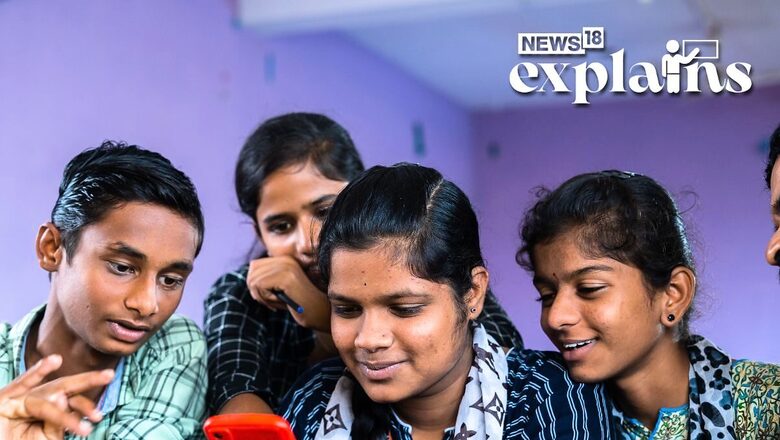
views
An analysis of examination results of secondary and higher secondary (Class X and XII) of 60 different state school and central boards in the country by the Union Ministry of Education (MoE) has found stark regional variations in the academic choices made by students. Science is the most popular stream among students in southern states, and as one moves north and northeast, the preference lies in arts/humanities, and commerce stream stands as the least opted across boards.
Three out of the five large states where science is the preferred choice of high school level students belong to the southern region. In northern, north-eastern (except for Manipur) and eastern parts of the country, arts are the most popular academic stream among students. This shows major unevenness in the distribution of students across streams in different regions.
This disparity exists in the pass percentages of students of different boards, while also showing significant number of students dropping out of high school. Uttar Pradesh (UP) and Bihar are on the top of the student-dropping out list.
While this analysis is based on the exam results of 2022, the trend for the choices has been more or less the same for the past 10 years, as per the Ministry. While the variations are clearly reflected in the number of those making to the top engineering and medical colleges in the competitive exams, which has southern states like Telangana and Andhra Pradesh in the top five states almost every other year; the study is first such attempt by the Centre to identify the challenges of such disparities.
What prompted the analysis?
It was prompted by the new National Education Policy (NEP) 2020, which recommends the setting up of a national assessment centre, PARAKH (Performance Assessment, Review, and Analysis of Knowledge for Holistic Development), as a standard-setting body for the various state boards to allow a level-playing field for all.
While this was just based on a year’s results, the department of school education and literacy under the Ministry is set to carry out a preliminary study of 10 state school boards as a basis for a deeper evaluation of the challenges. The study will start this June and is likely to be completed by November-December this year.
Which are the states that have the most takers for Science, Arts?
Andhra Pradesh, Telangana and Tamil Nadu have a much higher percentage of students studying science in higher secondary — 76%, 65% and 62%, respectively. In these three southern states, only 2% students were found to have opted for arts/humanities.
Then there is Manipur (69%), the only north-eastern state with such a high percentage of those opting for science in higher secondary. This is followed by UP (57%), Central (50%), Kerala (45%), Maharashtra (44%), Jammu and Kashmir (43%), Bihar (41%) and Chhattisgarh (40%) where science stream has been the most popular choice of students.
In other north and north-eastern states, the percentage of those opting for science was much lower — Assam (17%), Haryana (15%) and Punjab (13%).
Data shows that the rest of north-eastern, eastern and northern states had high takers for arts. Among all other states, Tripura had the highest percentage — 85% — of students opting for arts, which was followed by Meghalaya (83%), Gujarat (82%), Nagaland (80%), West Bengal (79%), Mizoram (78%), Assam (74%), Rajasthan (71%) and Jharkhand (69%). The two hill states — Uttarakhand and Himachal Pradesh (HP) — each have 61% of overall students who opted for arts.
Where does the Commerce stream stand?
The analysis report stated that commerce stream has stagnated at same level over the last 10 years with only around 14 % of overall students opting for it. Even the highest percentage of students opting for commerce stands at just 37% in Karnataka, which is followed by Tamil Nadu (32%) and Goa (31%).
Science and arts have consistently been the most popular streams over the last 10 years. Students opting for science and arts streams have increased from 31 % in 2012 to above 40% in 2022. Student’s choice for vocational courses is also increasing; commensurate seats at higher education level may be required, it stated.
How is the disparity in pass percentages of different boards?
There are stark variations in the percentage of students passing from different boards. At the secondary level while Meghalaya has only 57% students passing, Kerala has a pass percentage of 99.85%. Punjab ((97.8%), Telangana (97.6%), J&K (62%) and Madhya Pradesh (MP) (61%).
For higher secondary, the results are completely different. Tripura (97.6%), Punjab (97.2%), Rajasthan (96.6%), J&K (71%), Karnataka (75%), MP (78%), Andhra Pradesh (69%).
This variation could be because of different boards functioning at different levels, different syllabus, approach and pattern of assessment followed by each of them, said an official explaining the probable reasons behind the large variations.
How many students are dropping out after class XII? What does it mean?
At higher secondary level (class XII):
As many as 23.4 lakh students are dropping out after class XII due to exams while 18.6 lakh students are failing the exam and 4.8 lakh students not appearing for the exam altogether. The failure rate in Open school is significantly high.
There are 11 states that contribute 77% of the total dropouts with UP and Bihar being on top of the list. The figures are as as follows — UP (5.4 lakh), Bihar (3.4 lakh), MP (1.7 lakh), Karnataka (1.6 lakh), Andhra Pradesh (1.5 lakh), Tamil Nadu (1.4 lakh), Telangana (1.2 Lakh), WB (1 lakh), Maharashtra (0.95 lakh), Kerala (0.8 lakh), Gujarat (0.7 lakh).
The significantly high dropout and failure rate means low gross enrolment ratio (GER) at graduation level, which is affecting India’s rank in global indices. It further indicates a need for focussing attention to teacher training and recruitment, reforms needed at Open school exams, as only 5.5 lakh are enrolling against overall 23.4 lakh; and that the 4.8 lakh students who are not appearing for exam might be potential candidates for skill based training to retain them.
At secondary level (class X):
A total of 35 lakh students of class X are not reaching class XI while 27.5 lakh students are failing and 7.5 lakh students not appearing for exam. Failure rate in Open school is significantly high.
There are 11 States that contributes 85% of the total dropouts. These are — UP (5.9 lakh), Bihar (5 lakh), MP (4.4 lakh), Gujarat (2.6 lakh), TN (2.2 lakh), Rajasthan (2 lakh), Karnataka (2 lakh), Assam (1.8 lakh), WB (1.9 lakh), Haryana (1 lakh), Chhattisgarh (1 lakh).
It means a low GER in classes XI and XII, which is affecting India’s rank in global indices.
How many state, central boards exist in the country?
Total Examination Boards increased from 50 in 2012 to 60 in 2022. The top five boards — UP, CBSE, Maharashtra, Bihar and West Bengal — cover about 50% of students enrolled while the rest 50% are enrolled in the remaining 55 boards across the country.
There are three type of central boards — Central Board of Secondary Education (CBSE), the Council for the Indian School Certificate Examinations (CISCE), and the National Institute of Open Schooling (NIOS).
There are several state education boards for Secondary School Certificate (SSC) and Higher School Certificate (HSC). Eight States — Andhra Pradesh, Assam, Karnataka, Kerala, Manipur, Odisha, West Bengal and Telangana — have separate examination boards for secondary and higher secondary level.
Different international boards are also functioning in Indian education system — Cambridge Assessment International Education (CAIE) and the International Baccalaureate (IB).
Each Board follows its own standard, syllabus and time lines for exam and results, which according to the study, essentially means that there is no level playing field for students in terms of standard and movement across the boards. Different syllabus followed by different boards creates barriers for national level common tests such as CUET, JEE and NEET, among others, as compared to central board students.




















Comments
0 comment